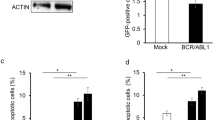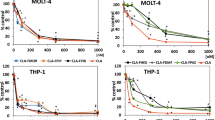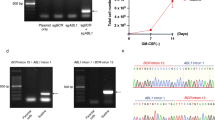Abstract
We studied the effect of phosphorothioate oligodeoxynucleotides ([S]ODNs) complementary to the bcr-abl junction on cells taken at diagnosis from 41 patients with Philadelphia-positive chronic myelogenous leukaemia (CML). Experiments included the evaluation of the anti-leukaemic effect of 16- and 26-mer antisense [S]ODNs on both mononuclear and CD34+ cells, evaluation of incubation time and correlation of colony growth inhibition with the down-regulation of p210bcr-abl. At the same time, the uptake of [S]ODNs by mononuclear and purified CD34+ cell populations and the cross-hybridization of 26- and 16-mer [S]ODNs with the complementary sequences were evaluated. After incubation for 120 h with 26-mer antisense [S]ODNs on mononuclear cells, overall mean colony recovery was 41.9% of the untreated control samples; in particular, a significant reduction in colony formation was observed in 22 of the 35 cases tested. The effect of 26-mer ODNs on CD34+ cells was comparable to that observed on mononuclear cells in terms of colony inhibition; however, a higher proportion of cases showed a significant inhibition of colony formation. In comparison with the 26-mer antisense [S]ODNs, the anti-leukaemic effect of the 16-mer antisense [S]ODNs was less evident on mononuclear cells and comparable on CD34+ cells; however, a more specific effect was evident on both target cells. Hybridization experiments confirmed a partial cross-reactivity when the 26-mer ODNs were hybridized with their complementary sequence; this did not occur when 16-mer ODNs were similarly tested. Experiments aimed at evaluating the effect of the incubation time showed a significant increase in anti-leukaemic effect after a 120 h incubation period compared to that measured after a 24 h incubation period; this was parallelled by a progressive increase in the intracellular concentrations of [S]ODNs from day 1 to day 5. The accumulation of [S]ODNs correlated with a marked down-regulation of p210bcr-abl levels which was first detectable after 72 h of treatment. The down-regulation of p210bcr-abl levels following treatment with [S]ODNs showed a correlation between the effect of antisense [S]ODNs on leukaemic colony formation and protein expression. These studies confirm that, under optimal conditions of target cell culture and ODN size, antisense [S]ODNs complementary to the bcr-abl junction have specific anti-leukaemic effects.
This is a preview of subscription content, access via your institution
Access options
Subscribe to this journal
Receive 12 print issues and online access
$259.00 per year
only $21.58 per issue
Buy this article
- Purchase on Springer Link
- Instant access to full article PDF
Prices may be subject to local taxes which are calculated during checkout
Similar content being viewed by others
Author information
Authors and Affiliations
Rights and permissions
About this article
Cite this article
de Fabritiis, P., Skorski, T., De Propris, M. et al. Effect of bcr-abl oligodeoxynucleotides on the clonogenic growth of chronic myelogenous leukaemia cells. Leukemia 11, 811–819 (1997). https://doi.org/10.1038/sj.leu.2400664
Received:
Accepted:
Issue Date:
DOI: https://doi.org/10.1038/sj.leu.2400664
Keywords
This article is cited by
-
BCR/ABL: from molecular mechanisms of leukemia induction to treatment of chronic myelogenous leukemia
Oncogene (2002)
-
Frequent polymorphism in BCR exon b2 identified in BCR-ABL positive and negative individuals using fluorescent hybridization probes
Leukemia (2000)
-
Antisense therapeutics in chronic myeloid leukaemia: the promise, the progress and the problems
Leukemia (2000)
-
Myb targeted therapeutics for the treatment of human malignancies
Oncogene (1999)



